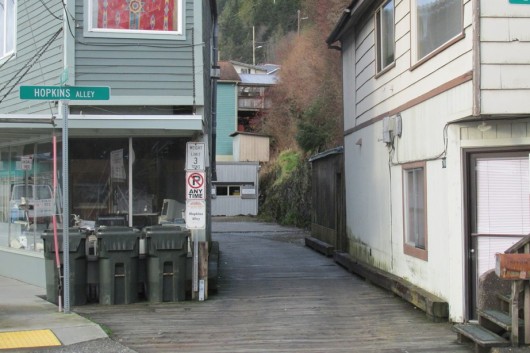
Also Thursday, the Council unanimously agreed to authorize $25,000 to move forward with Phase II of the long-planned Hopkins Alley revitalization project.
Ketchikan City Council members expressed reluctance Thursday to take on the full responsibility of fixing a failing sea wall at Thomas Basin, but agreed to let the city facilitate meetings with the various property owners along that stretch of shore, in hopes of finding consensus on how to move the project forward.
The city and private property owners shared the cost of an evaluation of the sea wall, which was built many years ago of sheet metal piling. The study was conducted by PND Engineers, and that company’s Vice President, Dick Summerville, presented the report to the City Council at Thursday’s regular meeting. He showed slides as he talked about the existing conditions, which, frankly, aren’t good.
“You can see the paper-thin to no steel left in a good section of this wall,” he said. “We found heavy corrosion throughout the wall. In some cases, we found behind the wall voids that you could put a small Volkswagen in, maybe refrigerator-size stuff, and that’s throughout the wall.”
The engineering firm then came up with options to repair the wall. They range in cost from $2.1 to $8.3 million. Nobody seemed willing to go with the high-end option, but Summerville said the low-end probably isn’t a good choice, either, because of potential effects on salmon returning to Ketchikan Creek, and other environmental concerns. Two mid-range options cost between $3.3 and $3.8 million.
In addition to the city and private property owners, any plan will have to pass state permitting scrutiny, and the feds, because part of the failing sea wall is on federally owned property.
City Manager Karl Amylon said that finding consensus with all those players is going to be difficult.
“I think the biggest challenge in this process is getting any kind of decision out of the federal government,” he said. “That’s going to take months, if not longer. And then how that is going to dovetail into what the other property owners and what the City Council may do? I don’t know.”
The city does have a meeting set up with a representative of the federal General Services Administration, which owns the property in question. That will be just the start of the process.
While most Council members agreed something needs to be done about the failing retaining wall, whether the city has a financial responsibility to fix it was debated. And then there’s the waterfront promenade, which can’t be completed until the sea wall is fixed.
Council Member Dick Coose argued that the city could use cruise head tax funds to pay for the project, because it clearly benefits cruise passengers.
Council Member Matt Olsen, participating by phone, said that it would cost less and get done faster if the city takes a backseat role.
“I am a little concerned that if we are the ones that become the drivers, all of a sudden, we’re going to become the ones that are wholly responsible,” he said. “We need to try to come up with a third party who can be involved as a project manager, and have someone who is a little outside the realm of the politics, and just trying to make sure the process works forward.”
The City Council didn’t make any hard decisions on that issue Thursday night. They agreed to first see what the various property owners want.
Also Thursday, the Council unanimously agreed to authorize $25,000 to move forward with Phase II of the long-planned Hopkins Alley revitalization project. That’s a joint effort involving the city, the Ketchikan Gateway Borough and property owners in the Hopkins Alley area.
The borough also is expected to contribute $25,000 for the project.
Two executive sessions at the end of Thursday’s meeting to discuss ongoing contract negotiations with the International Brotherhood of Electrical Workers ended without any action by the Council.
The next regular City Council meeting is Feb. 5.






